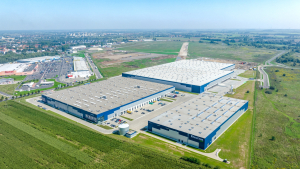
The development pipeline of logistics centres is still powerful around Budapest but some of the players seek other opportunities near regional industrial cities. However, landlords need to adapt to market changes while adjusting their rental conditions. Property Forum asked Gábor Halász-Csatári, Head of Industrial & Logistics Agency at Cushman & Wakefield about the latest trends in meeting demands and the pivotal role of fulfilment services in Hungary.
Due to local conflicts, global supply chains continue to face constant threats and logistics providers suffer losses. What is this impact on developers of industrial properties, especially in CEE?
Developers throughout the CEE region are grappling with challenges arising from stagnant or declining demand from 3PL and fulfilment service providers. While major capital cities and regional markets maintain relative stability, the influx of new supply in previous years has resulted in a noticeable slowdown in new development announcements and deliveries. Consequently, vacancy rates have seen a modest increase, although they generally remain below the 10% threshold across the region.
In Hungary, the rental rates are currently undergoing a significant reassessment, driven by developers engaging in intense competition to secure tenants. This heightened competitiveness has spurred adjustments in headline rates, with some developers opting for outright reductions, while others are enticing prospective lessees with attractive incentive packages. Notably, landlords are showing a greater willingness to adapt to market dynamics by offering increased flexibility in rental periods.
E-commerce has been on the rise but has decreased since households began to focus on their energy and grocery bills. How will it affect the demand for industrial space in big boxes and city logistics?
What we're witnessing is a deceleration, rather than a decline, in e-commerce activity. In Hungary, a significant 46% of all demand in 2023 originated from e-commerce or wholesale tenants, translating to over 300,000 sqm of transactions within this sector alone. Based on our observations, CEP service providers persist in their growth trajectory, stimulating demand across both asset classes, albeit with a slightly heightened emphasis on last-mile solutions or city logistics.
Interestingly, the competitive landscape has shifted from merely offering next-day delivery to a race towards providing delivery within an hour. This evolution underscores the intensifying focus on meeting consumers' increasingly demanding expectations for swift and convenient delivery services.
As we see a big wave of industrial developments, suitable industrial lands are in short supply around Budapest. Thus the price of available lands has increased dramatically. Is there any space for further rise?
We remain optimistic about the availability and pricing of land in and around Budapest. Despite current limitations in demand, a wide range of options exists across all sub-markets. We believe that as market fundamentals improve, there will be renewed interest and activity in land transactions. Additionally, Budapest maintains its affordability compared to many other regional capitals, offering a competitive advantage for developers.
However, we suggest shifting focus towards regional cities, where substantial industrial development has materialised or is in the planning stages. These areas present significant opportunities for both direct and speculative investments.

Gábor Halász-Csatári
Partner, Head of Industrial Leasing
Cushman & Wakefield
Gábor Halász-Csatári is the head of the Industrial & Logistics Agency at Cushman & Wakefield in Hungary. He took over the department in 2014 and became the official Head of Department in April 2015. He was nominated to Associate position in June 2016 and Partner of the firm in 2019.
Construction and maintenance costs of industrial facilities do not tend to decrease. How can this be managed by the logistics centre’s developers and facility management firms?
Construction costs have recently shown some degree of consolidation year-on-year. In response, developers are recalibrating their offered rental rates to align with their cost structures and profit expectations. This adjustment process, combined with prevailing demand dynamics, will ultimately determine the nominal rental rates. Over the past few years, rental rates have been on a steady upward trajectory. However, this trend has recently plateaued due to several factors including an uptick in vacancy rates, stabilisation of construction costs, and the emergence of more competitive market conditions.
In property and facility management, Hungary's elevated CPI is anticipated to trigger higher nominal wage increases. Consequently, management fees will likely need to be adjusted upwards or their structures modified to account for the increased labour costs associated with these services.
We have seen a slight rise in vacancies over the last 12 months. How about the latest occupancy trends and headline rents in Budapest and regional industrial markets in Hungary?
Occupancy trends indicate an increase in the availability of warehouse space in Greater Budapest. These heightened supply levels intensify competition among developers, consequently exerting downward pricing pressure. Conversely, regional markets present a distinct landscape. Developers in these areas typically lean towards BTS solutions rather than speculative projects, resulting in lower vacancy rates. Consequently, prices in regional BTS transactions remain relatively consistent and are influenced by factors such as location, project complexity, profitability expectations, and the construction costs incurred by the developer.
Logistics services are gaining more importance than ever before. How would you describe one part of them, the fulfilment market in CEE and Hungary?
Fulfilment services have emerged as a prominent topic in the sector, underscored by Cushman & Wakefield's involvement in the largest fulfilment deal in Budapest, spanning 62,000 sqm in 2022. Fulfilment service providers operate at the intersection of logistics, value-added supply chain management, warehousing, and CEP services. Leveraging highly sophisticated IT networks, cutting-edge robotics, and AI, these providers require premium-quality floor space, modern infrastructure, and strategic locations.
Fortunately, Hungary boasts a wealth of industrial and logistics developers who precisely offer these requirements, making it an attractive destination for fulfilment operations. With industry giants like Temu, Shein, and other cost-effective Chinese e-commerce behemoths entering the market, the sector is poised for substantial growth in the region.
How about big international players in the fulfilment market entering the CEE region?
As mentioned earlier, prominent e-commerce companies from the Far East are rapidly gaining traction in the region, aiming to streamline supply chains by establishing operations in CEE. This strategic move has a profound impact on the demand for e-commerce and fulfilment services across the region.



